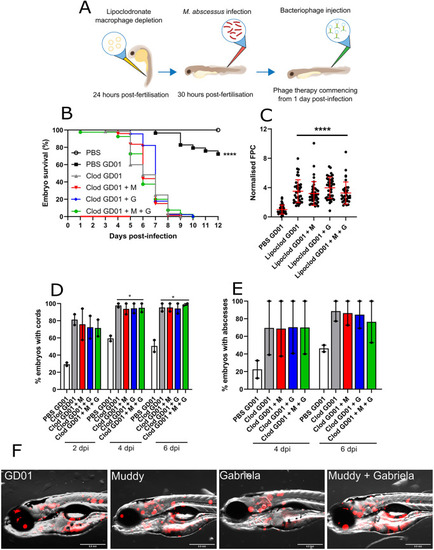
Activity of Muddy in GD01-infected zebrafish lacking macrophages. At 24 hpf, embryos were micro-injected with either PBS liposomes (PBS) or lipoclodronate-filled liposomes (Clod) to achieve macrophage depletion. At 30 hpf, treated embryos were infected with 250-300 CFU of GD01 (PBS GD01 and Clod GD01) via caudal vein injection. At 1 dpi, embryos commenced phage therapy through caudal vein injection at an MOI of 50:1 (phage:bacteria) based on initial bacterial infection inoculum. Embryos were treated daily from 1 dpi, up to and including 5 dpi with Muddy (M), Gabriela (G) or a phage cocktail containing both Muddy and Gabriela (M+G). (A) A generalised schematic showing the experimental design corresponding to the figure. (B) Embryo survival was monitored over a 12 day period, with embryos counted daily. Survival curves were analysed using the log-rank (Mantel–Cox) statistical test. The red bar across the x-axis indicates the duration of daily phage administration in the current experiment. (C) Bacterial burden (FPC) was analysed at 6 dpi using fluorescent microscopy. Fluorescent images were analysed in ImageJ using the ‘Analyze particles’ function. Bacterial burden was analysed using a Kruskal–Wallis one-way ANOVA. (D,E) The proportion of embryos with cords (D) and abscesses (E) was enumerated at 2, 4 and 6 dpi using fluorescent microscopy. Abscess and cord quantification was analysed using a Kruskal–Wallis one-way ANOVA. Data shown are the mean of two independent experiments±s.d. (n=20-30 per group for each experiment). (F) Representative zebrafish images of untreated (GD01) or phage-treated embryos at 6 dpi, showing the presence of extracellular bacterial cords. Red overlay represents GD01 expressing TdTomato. Scale bars: 0.5 mm. *P<0.05; ****P<0.0001.
|